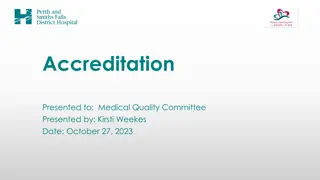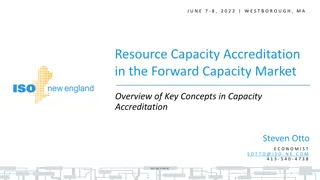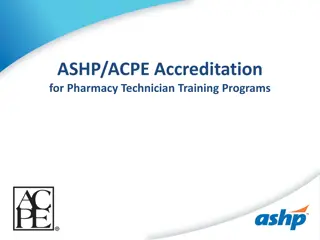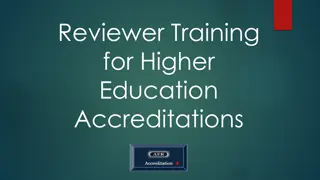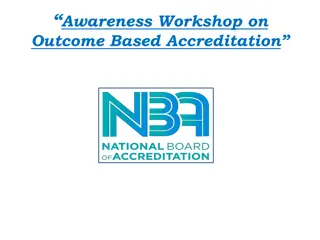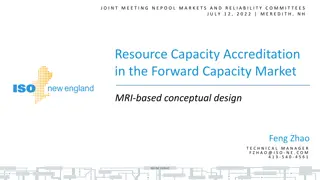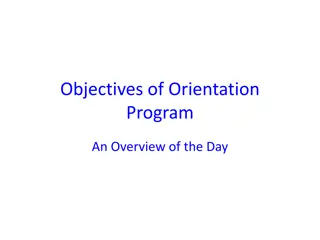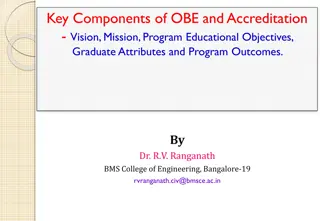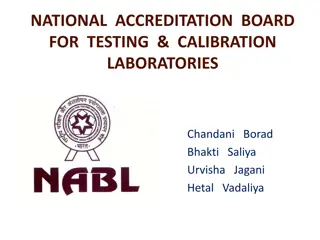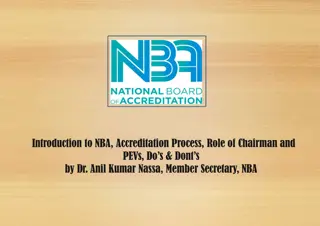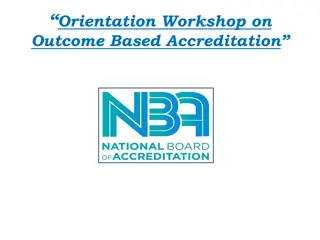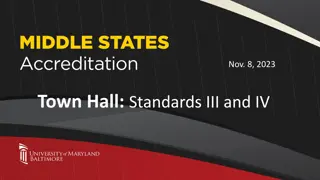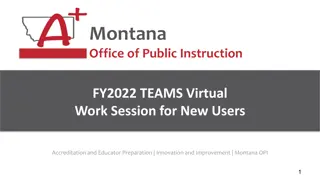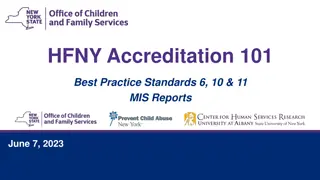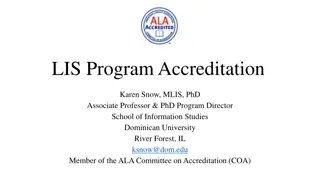Understanding Academic Accreditation and Program Evaluation
Academic accreditation aims to assure stakeholders of program quality, aligning with international standards. Accreditation applies to programs, not institutions. Different types of accreditation exist, such as initial program accreditation and renewal of program accreditation. Programs consist of formal courses leading to qualifications, assessed through Program Learning Outcomes.
- Academic accreditation
- Program evaluation
- Qualification standards
- Learning outcomes
- Education quality
Download Presentation

Please find below an Image/Link to download the presentation.
The content on the website is provided AS IS for your information and personal use only. It may not be sold, licensed, or shared on other websites without obtaining consent from the author. Download presentation by click this link. If you encounter any issues during the download, it is possible that the publisher has removed the file from their server.
E N D
Presentation Transcript
E-Workshop 2 Preparing External Reviewers and the Onsite Visit CAA Certified Reviewer Project Commission for Academic Accreditation Ministry of Education, UAE 1
Session 4: Reviewing the Academic Program and Learning Outcomes Prof. Stephen Arkle Commissioner Commission for Academic Accreditation Ministry of Education, UAE 2
Purpose of Accreditation? To assure stakeholders (e.g. prospective students, their families, and employers) that the qualifications offered by institutions meet published (CAA Standards) consistent with current international practice and professional judgment. To enhance the quality of academic provision and promote high quality experiences for students. Accreditation is applied to programs, not institutions. 3
Types of Accreditation? Initial program accreditation (IPA), when a new program is proposed by a licensed institution to be accredited for the first time. Renewal of program accreditation (RPA), to renew the accredited status of a program. The CAA Standards are differently applied in these situations according to the Procedural Manuals o For IPA o For RPA 4
Program? What is a program? The set of courses and other formally established learning experiences which together lead to a qualification. The program does not sit in isolation. UAE follows well-established international practice of defining the qualifications to be awarded by volume of learning and academic level. 5
What is a program? Volume: Credit hours (other volume measures are accommodated according to equivalence). Level: According to the National Qualifications Framework (NQA; QFEmirates) o Associate Degree/Diploma (QFEmirates Level 5) o Higher Diploma (QFEmirates Level 6) o Baccalaureate or Bachelor's degree (QFEmirates Level 7) o Postgraduate Diploma (QFEmirates Level 8) o Master's degree (QFEmirates Level 9) o Doctorate (QFEmirates Level 10) 6
What is a program? Qualifications are awarded according to program titles. Students must demonstrate that they are deserving of the award of the specific qualification level and title in order to graduate. They do this by demonstrating academic achievement that they are assessed on. The achievements that students must demonstrate attainment of are the Program Learning Outcomes (PLOs). It is outcomes that they are assessed against. Awards are outcomes-based. Attainment must be at a specific standard or above (grade) and a sufficient volume of learning must have been undertaken. Completion requirements therefore include grade and CH requirements. 7
Accreditation Program: The set of courses and other formally established learning experiences which together lead to a qualification. A well-designed program is not sufficient on its own: The CAA needs to ensure that the provider's academic provision has made, and continues to make available to students appropriate learning opportunities, which enable the PLO to be achieved. Its not just about the courses on offer. Program must have effective support o Human, physical and fiscal resources o Management, planning and regulation o Scholarship and research o Quality assurance and enhancement All considered at accreditation. 8
Standards considered at accreditation Section 1: Quality Assurance (Standard 2) Section 2: Educational Programs (Standard 3) Section 3: Research & Scholarly Activities (Standard 4) Section 4: Faculty and Professional Staff (Standard 5) Section 5: Students (Standard 6) Section 6: Learning Resources Centre (Standard 8) 9
Initial Accreditation The review of the ERT determines whether: There is evidence that the requirements of the Standards for a new program are met. The program will be offered with due regard to international best practice and benchmarks associated with the discipline field. The program (program outcomes) is aligned with the appropriate level descriptors articulated in QFEmirates. If applicable, any professional body requirements have been embraced within the program outcomes. o o o o 10
Accreditation The review of the ERT determines whether: There is evidence that the requirements of the Standards are continuing to be met. The program has been offered with due regard to international best practice and benchmarks associated with the discipline field. Any professional body requirements have been embraced within the program outcomes, if applicable. Internal monitoring and review processes have been implemented and the results of those processes used for continuous improvement. o o o o 11
QFEmirates A basic question for an ERT is whether a new (IPA) program, or an existing program (RPA) demonstrably meets the level descriptors of the QFEmirates. QFEmirates defines specified standards of knowledge, skills and competence required at each academic level. 12
QFEmirates Level descriptors are divided into strands with explicit statement of what knowledge, skills and competencies must be attained and demonstrated: These are defined by HEIs in the context of their programs by the PLOs. 13
PLOs and CLOs PLOs are inherently broad statements as they recognize the learning outcomes of an entire program, attained through the achievement of CLOs across the program. Consequently, PLOs can and should be broader to effectively capture the breadth and depth of student learning, skills acquisition and competencies developed across the program. CLOs are written to state what students will demonstrate attainment of through successful completion of courses. It is at course level that the main assessment of learning outcomes takes place, against the specified CLOs. Student assessments must determine the level of achievement of CLOs, and CLOs must map to PLOs to demonstrate that attainment of CLOs leads to achievement of PLOs. 14
Alignment of PLOs to QFEmirates One of the more challenging aspects of evaluating learning outcomes is ensuring they are pitched at the right level for the qualification being awarded, in alignment with the required QFEmirates level descriptors. The verb used will reveal the levels at which students are expected to perform in order to demonstrate the achievement of the PLO. In reality it is essential that both of the verb and the scope and guidance elements are addressed to ensure that the level is clear. o The verbs used to describe the learning outcome; and o The scope of the task and quality of the guidance given to the students. 15
Alignment of PLOs to QFEmirates Verbs used- The verbs are used to describe what activity the learning outcome requires of the student. Many institutions use verbs based on Bloom s Taxonomy (or Millar s Triangle). Scope and guidance- The scope of what a student is expected to attain relates to the detail, depth and breadth of their expected attainment, the amount of complexity they are dealing with, the use and evaluation of different theories and approaches and the amount of uncertainty contained in the material they are using. 16
Alignment of PLOs to QFEmirates Examples of the two elements verbs and scope and guidance being used to differentiate level: Upon successful completion of the program, the student will be able to Level 5: Analysis- analyse with guidance using given classifications and principles. o Level 7 : Analysis- analyse new and/or abstract data and situations without guidance, using a range of techniques appropriate to the subject. o Level 9 : Analysis- analyse new and/or abstract data (including incomplete data) and situations using a range of advanced techniques relevant to the subject and demonstrate self-direction and originality in explaining and interpreting outcomes. o 17
CLOs vs. PLOs CLOs specifically describe what students will have attained by end of the course they need to be capable of being assessed. If not, they cannot fulfil one of their core purposes. CLOs establish course content and the range and type of teaching, learning and assessment activity that students will experience. CLOs serve the following core purposes: o Establish course content, o Influence the range and type of teaching and learning activity on the course, o Form the basis of assessment activity, o Inform students what is expected of them, and o Contribute to the achievement of one or more PLOs. 18
CLOs vs. PLOs Example PLO On successful completion of the program the graduate will be able to evaluate critically and develop solutions to a range of ICT problems facing on-line retail businesses. CLO On successful completion of the course the student will be able to evaluate alternative software packages for website development and design and upload a front page for a live site 19
Common CLO problems Unclear what students are expected to focus on and how the assessment will test whether they are able to demonstrate they have achieved the CLO. Too many learning outcomes. It is important to identify the essential things students will know and be able to do at the end of the course. If there are too many CLOs this will cause problems with assessment as the HEI will not be able to assess all of them or will overload the students with too much assessment. Assessments do not test attainment of the CLOs. 20
Common CLO problems CLOs are written too broadly and are pitched more at program level, or written using vague or passive terms such as appreciate, understand, be familiar with . It is very difficult to assess these outcomes. The language used to write CLO needs to be clear, unambiguous and written in a way that communicates what a student will know and be able to do at the end of the course. Not pitched at the correct level for the award which is aligned with QFEmirates. 21
Summary Program reviews take into account a wide variety of elements IPA and RPA have different emphasis Directed by the 2019 Standards Need to comply with QFEmirates Levels 22
Group Homework Discuss who you would wish to interview from XYZ University following your recent desk review? Justify your agreed answers against the Standards. Part 2 Keeping in mind the first part of this question - write 2 questions for each of the people you have identified to illicit the information needed. Group Coordinator to email the group s report to the group s Commissioner by 5pm Wednesday 23



